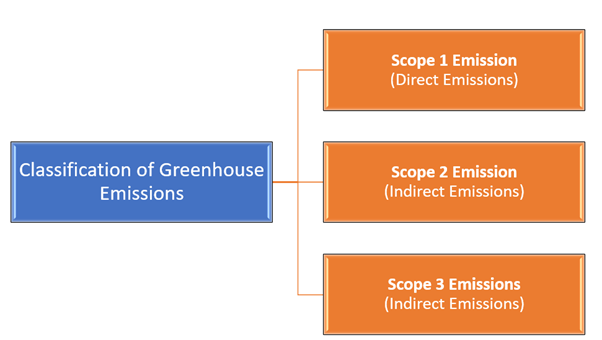Carbon Emission
Updated on 2023-08-29T12:00:40.499058Z
Carbon Emission is the process of release of carbon compounds into the atmosphere. Carbon emission is directly linked to greenhouse emission and is the main contributor to greenhouse emission. The percentage of carbon emission has increased enormously after the start of the industrial revolution and urbanisation.
How is carbon increasing Greenhouse Emission?

Copyright © 2021 Kalkine Media Pty Ltd
To understand how carbon increases Greenhouse emission, first, we have to understand what greenhouse emission is. Earth's surface absorbs solar radiation; however, few radiations are reflected back. The reflected radiations are partly absorbed by greenhouse gases present in the atmosphere. The entire process is known as the Greenhouse effect.
Actually, the greenhouse effect is one of the main reasons for making Earth a habitable planet. Greenhouse gases are naturally present in our atmosphere and help the planet maintain its temperature, which makes the planet more suitable for living creatures to sustain life. Greenhouse gases create a temperature difference on the Earth's surface otherwise, the temperature world range about minus 18 degree Celsius, making life difficult for living creatures.
Since carbon is also a greenhouse gas that contributes more than 80 per cent of greenhouse emissions, so it became a primary cause for the global temperature rise and global warming.
Why is everyone so concerned about carbon emissions?
Since we have seen that carbon can trap heat radiations to keep the Earth warm, this is a natural process going on for ages; so, why everyone is concerned about carbon emission. Actually, plants and trees absorb most of the carbon dioxide and balance the Earth's carbon levels, but due to increasing population, industrialisation, and urbanisation, increasing deforestation activities create a natural imbalance. The carbon level in the atmosphere is increasing day by day. The increased carbon footprints are the main reason for global temperature rise and global warming. Global warming is the main reason for the decrease in polar ice caps and global climate change pattern. Increased global warming would also lead to significant biodiversity loss and can create potential natural disasters like floods, avalanches etc.
What is Carbon Footprint?
Carbon footprints refer to the total amount of greenhouse gases, including methane and carbon dioxide, released into the atmosphere because of electricity and fuels. Carbon footprints are usually measured in tons of carbon dioxide equivalents during a period of a year. Carbon footprints can be related to an organisation, individual, country, product or event.
The average carbon footprint for a single person in the US is around 16 tons. However, the average carbon footprint around the globe is just 4 tons. The whole world is aiming to become carbon neutral by 2050. In order to avoid the 2-degree rise in global temperature level, the world has to reduce its average carbon footprint to under 2 tons by 2050. Making small differences in our lifestyle can be an efficient way to reduce carbon footprints significantly.
Why measure Carbon Footprints?
With rising, environmental reporting pressure along with other internal and external pressure, companies are forced to measure carbon emissions or carbon footprints. Measurement of carbon emission is necessary to have proper planning for its management. If an organisation wants to become sustainable, first, it has to understand its current emission levels.
Measurement and identification of carbon footprints can help organisations to reduce their operating costs substantially. A higher level of greenhouse emission directly indicates inefficient use of technologies and process. So, lowering of carbon footprints goes parallel to an increase in cost-effectiveness and efficient process.
Measurement of carbon Emissions:
An organisation's greenhouse emissions can be classified under three scopes as per corporate standards of Greenhouse gas emission protocols. Scope 1 and Scope 2 are mandatory for reporting whereas, and Scope 3 is optional and difficult to monitor. So, let us try to understand all three scopes in brief.

Copyright © 2021 Kalkine Media Pty Ltd
- Scope 1 Emission: Scope 1 emissions are direct emissions that come from organisation owned or controlled resources. For example, the emission that comes from the combustion of fossil fuels in vehicles owned by a company, its machinery, equipment, furnaces, boilers etc. This category may include greenhouse emissions through the release of fugitive gases, which are a thousand times more dangerous than carbon dioxide.
- Scope 2 Emission: Scope 2 emissions are indirect emission that comes from purchased energy from a utility provider. In simple words, we can say that the release of greenhouse emission through consumption of purchased stream or electricity. These emissions physically occur at the site where electricity is generated.
- Scope 3 Emissions: Scope 3 emissions are also indirect emissions that are not part of Scope 2 emissions. It includes all other indirect emissions that are not covered under Scope 2; however, these emissions are part of the organisation's activities. Few examples of Scope 3 emissions include greenhouse emission released in the atmosphere for the amount of fuel used by a company for transportation, emission caused by company used products and services etc.
What is Carbon Trading?

Copyright © 2021 Kalkine Media Pty Ltd
Carbon trading involves the process of buying and selling credits that allow the emission of carbon dioxide to the holder. In carbon trading, a government sets an overall limit on the carbon footprints for a specific period and grants permission or credit for the release of carbon emissions to polluters. The polluter must have enough credits to release carbon footprints. Every permit in this system is considered equivalent to one tonne of carbon dioxide. Credits are sold with an auction process to the polluters, and they are forced to put a price on their emissions, forcing them to release minimum emissions.
European Union Emissions Trading System is the world's biggest carbon trading system. However, countries like China and Brazil are still struggling to have a check on their emission levels despite the launch of a carbon trading system.